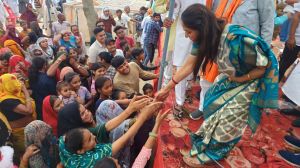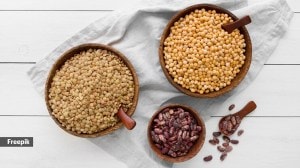- India
- International
Once a Hilsa trove, this Gujarat village now struggles to find catch
Hilsa, a marine fish much coveted in Bengali cuisine, migrates into the Narmada estuary to spawn and its peak upstream migration happens between July and August and continues till late November.
 Arjun Rathod tries to catch fish near Bhadbhut in Gujarat’s Bharuch district. (Express photo by Bhupendra Rana)
Arjun Rathod tries to catch fish near Bhadbhut in Gujarat’s Bharuch district. (Express photo by Bhupendra Rana)
Till five years ago, Santosh Machhi (30) used to catch up to 100 Hilsa fish a day from the Narmada that flows past his Bhadbhut village in Gujarat’s Bharuch district before opening out into the Gulf of Khambhat. Last year, his average daily catch never exceeded 10.
“My father and I own a boat and we caught all kinds of fishes from Narmada, which is worshipped as a Goddess in our village. Between July and September, Hilsa dominated our catch and brought us good returns. Not anymore,” said Santosh, who also plies an autorickshaw to ferry passengers to Bharuch city, about 25 km away.
“There is hardly any fresh water in Narmada today. The water you see is seawater that has gushed in due to high tide,” he added.
Hilsa, a marine fish much coveted in Bengali cuisine, migrates into the Narmada estuary to spawn and its peak upstream migration happens between July and August and continues till late November.
READ | Narmada downstream stretch now a thin stream, may hit local livelihoods

Chimanbhai Tandel, local fishing merchant and head of Bharuch Jilla Machimar Samaj, said Hilsa is also a delicacy in the area. “But unfortunately, Hilsa now comes here from Porbandar and Veraval,” he added.
“The fish market used to be flush with all kinds of fish from Narmada. One fisherman caught at least 50-100 Hilsa a day between July and September. The numbers have gone down to 10-15 a day,” said Tandel. “My annual earnings have dropped from Rs 1 crore to Rs 5 lakh. Even Katla has disappeared from this region,” said Tandel. According to him, a Hilsa laden with eggs fetches Rs 1200 a kg, while those without eggs fetch between Rs 600-800 a kg.
The main reason behind the fast depleting numbers of Hilsa is the shrinking brackishwater ecosystem in Narmada estuary which is funnel-shaped, about 72 km long and occupies 6,346 sq km. The estuary accounts for nearly 30 per cent of inland fish production of Gujarat.
According to a study by scientists of Kolkata-based Central Inland Fisheries Research Institute, the annual production of fishes from the estuary reduced from 15,889 tonne in 2006-07 to just 1,618 tonne in 2014-15. During the same period, Hilsa catch reduced from 5,180 tonne (2006-07) to 419 tonne in 2014-15.
Dibakar Bhakta, one of the five scientists who worked on the study published in 2018, refused to comment on the matter, saying he would need prior approval from seniors.
The numbers of Jumbo River Prawn in Narmada have also seen a rapid decline, say the fishermen.
Fishermen cite low river flow coupled with salinity ingress, and industrial effluents as the main reasons for the disappearing catch. The annual flow in Narmada, which was 23 MAF (million acre feet) in 1990, has reduced drastically. Currently, only 600 cusecs of water is released from the Sardar Sarovar dam.
Despite the heat, Arjun Rathod (40) has reached the river with an associate to catch prawns and fishes for dinner. “I have no idea where all the water disappeared in the last 10 years. Today, the river is a shadow of its former self,” said Rathod, stepping on to the riverbank that has turned white due to salt deposits.
“These days, I fish for over six hours and manage to get 500 gm of fish… Earlier, there were days when the catch used to be in kilograms,” he said.
Two raised platforms in the background mark the spot where the Bhadbhut Barrage is to come up, with an aim to prevent salinity ingress into the estuary.
PM Narendra Modi laid the foundation of the Rs 4,337-crore barrage project in October 2017. The project involves construction of a 1.6 km barrage across the river that will prevent saline seawater from entering the estuary which has already become shallow due to lack of freshwater from the Narmada.
“The government has stopped releasing water from Sardar Sarovar Dam. This has destroyed the brackish ecosystem in the estuary… it wants to build Bhadbhut Barrage to stop seawater. However, it will only end up killing the ecosystem for Hilsa,” said Tandel.
Local fishermen have made several representations to the government, asking them to release more water into the Narmada to help keep the local ecosystem alive. “Till now, our requests have fallen on deaf ears,” Tandel added.
Apr 25: Latest News
- 01
- 02
- 03
- 04
- 05








































